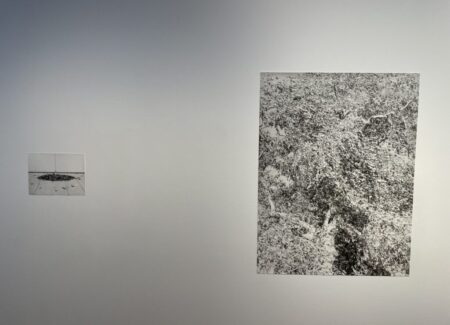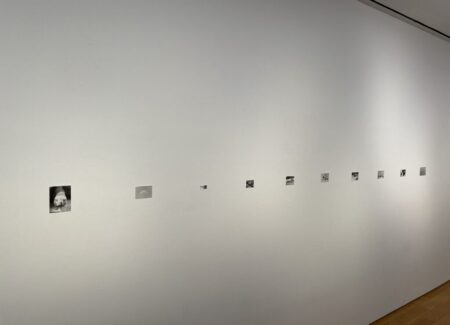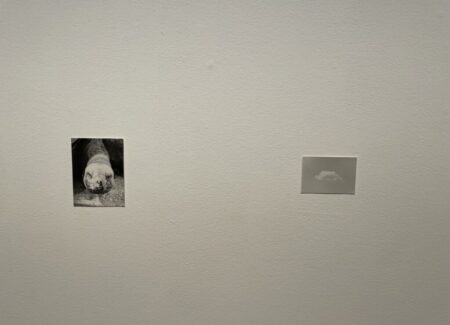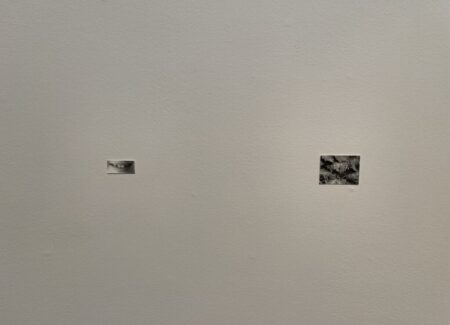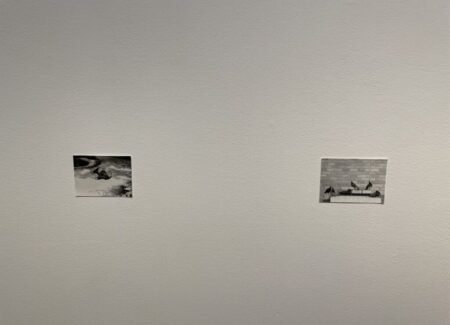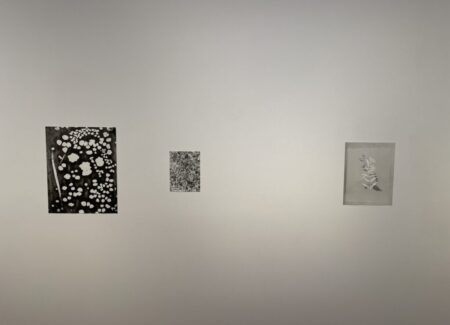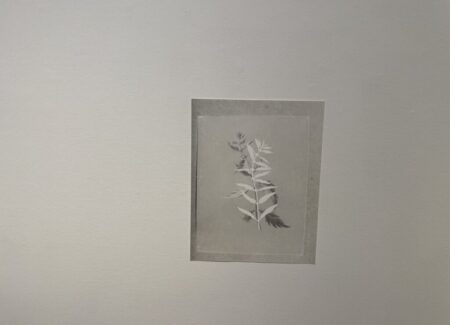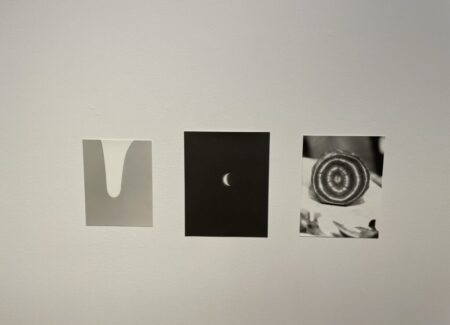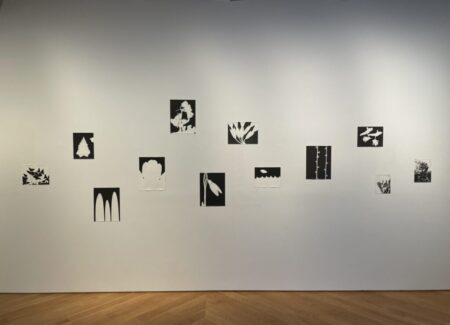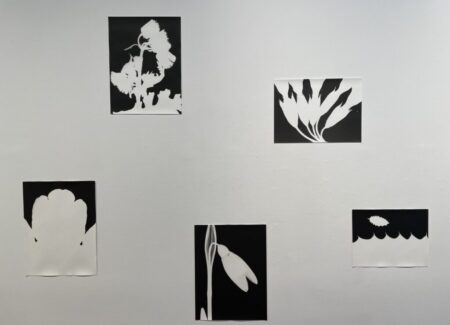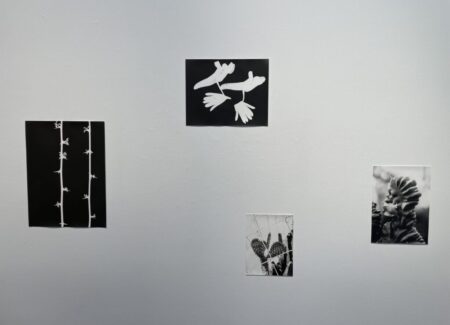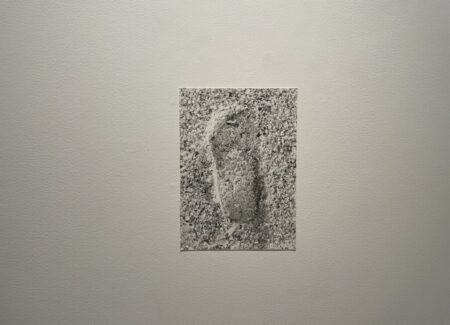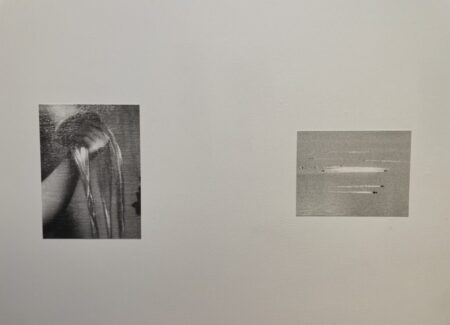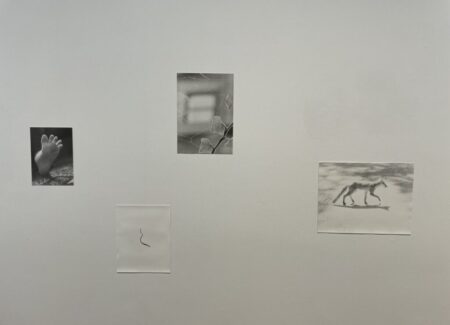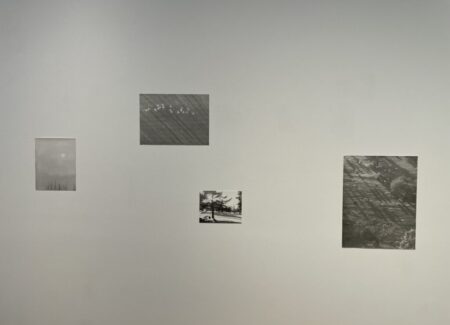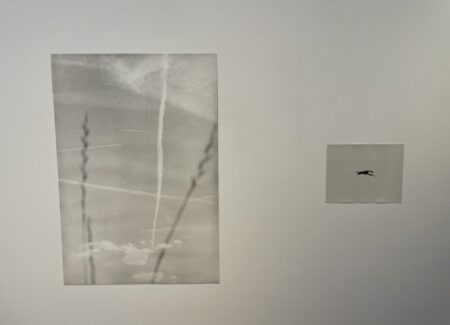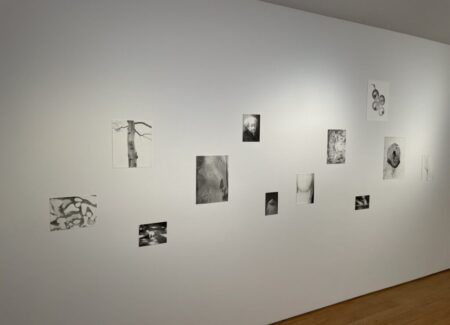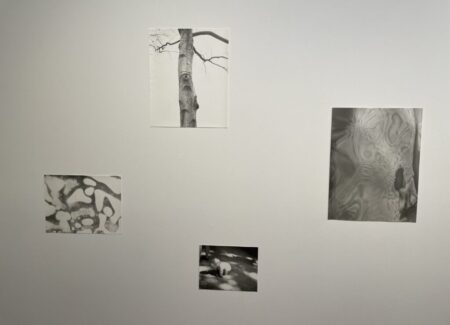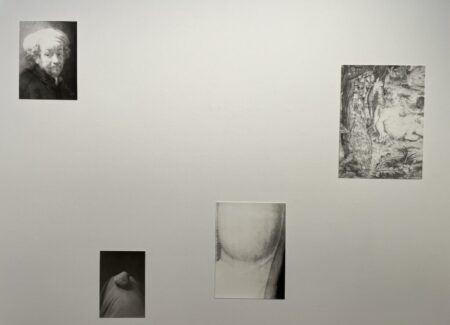JTF (just the facts): A total of 47 photographic works, unframed and affixed directly to the wall, in the third floor gallery space. (Installation shots below.)
The following works are included in the show:
- 32 gelatin silver prints, 2017, 2020, 2021, 2022, 2023, 2024, 2025, sized roughly 6×8, 7×8, 7×9, 8×6, 8×10, 9×6, 9×7, 9×11, 10×8, 10×12, 11×8, 11×9, 11×15, 12×9, 13×9, 13×10, 13×11, 15×11, 15×12, 17×13, 19×13, 19×14, 19×15, 37×26, 42×32 inches, in editions of 5
- 1 set of 10 gelatin silver prints, 2013, dimensions variable, in an edition of 5
- 14 gelatin silver prints, 2013, 2024, 2025, sized roughly 9×7, 9×11, 9×12, 10×13, 10×14, 12×9, 15×11, 15×12, 20×15 inches, unique
Comments/Context: One of the trickier aesthetic needles to thread in photography is how to make pictures that feel authentically poetic and associative, without treading into obvious, heavy-handed, or cloying image making. Visual clichés and bland seen-it-before genre traps abound, ready to ensnare the softly poetically-minded. And so the photographer who intentionally opts for an organically poetic path is actually asking for a particular kind of scrutiny, knowing full well that many viewers will come to the work with a healthy dose of quiet wariness, ready to see moody dark shadows or printing on delicately textured Japanese papers (for example) with some initial skepticism.
The German photographer Jochen Lempert’s images skirt this poetic minefield with dexterity, opting instead for a kind of wide-ranging visual curiosity and wonder that diffuses any sense of mannered fussiness, while still being open to small moments of unexpected transcendence. Trained as a biologist and steeped in the processes of experimental film – two perspectives that don’t normally coincide all that often – Lempert’s photographic eye mixes attentive natural discoveries (scaled from the micro to the cosmic) with deliberately crafted photograms and other chemical abstractions, in search of the connections that bind these disparate elements together. Displaying his prints unframed and affixed directly to the gallery walls in clusters, clouds, and sequences of images (in installations similar to those of Wolfgang Tillmans, albeit on a more intimate scale), Lempert encourages single images to expand into themes, conceptual echoes, and formal associations, the in-between links giving the individual photographs new resonances.
Lempert isn’t particularly well known here in the United States (this is his first solo show with Anton Kern), but many photo enthusiasts and collectors will recognize Lempert from some of his photobooks – he’s been a prolific book maker in the past decade, with books like Natural Sources (from 2025), Paare (2022), Relación (2018), Phenotype (2013), and others easily filling up a shelf. And given Lempert’s aesthetic vantage point, the control provided by the photobook form, in terms of everything from image sequencing to paper stocks, is well aligned with the ways he wants to explore and present his work.
While most of the photographs in this show were made in the past few years, Lempert’s shuffled style also incorporates images made more than a decade ago, the new informing the old and vice versa, depending on how the images are placed in proximity and dialogue with one another. In small sequences of pictures, he finds connections based on wind (between a windswept pile of leaves and the texture of leaves blown by the breeze), on the delicate spotted forms of bee pollen, and on circular motifs (of a chemical flow, a tiny crescent moon, and a striped beet). He then pares his aesthetics down to the high contrast black and white of silhouetted photograms, playing with the possibilities of leaf patterns, blossom forms, strings of vines, and darkroom washes, before ultimately returning to similar echoes found in a cactus (as seen behind chain link fence) and a bulbous succulent.
But as seen in another corner, Lempert’s visual harmonies are never exactly one-to-one or rigidly one-after-another sequenced, but are arranged in more of a networked flow of one-to-many, like a matrix of netting that connects different pictures together in different ways. Images can be linked by subject matter (feet and footprints, striped or linear forms, misty fogs), by textures, by structural elements, or by less identifiable essences. A cropped close of up falling water in an Ingres painting finds communion with an abstract light drawing, while a squiggling earthworm and a flying ibis are both reduced to gestural black marks against white backdrops. Soft whitewashing also plays a role in images of the moon through fog, an overexposed fox, and the brightness of light coming through dark trees at a park.
Another extended cluster of images makes connections of dappled light (in the mottled surface of ice and the sunspots around a toddler trying to stand up), of knees and arms, of stretching skin-like surfaces, and of eye-like forms (including a knot on the side of a tree trunk, tomatoes on the vine, and one strangely illusionistic view of a peacock seen head on). The artistic mind that finds resonances between these various images is clearly creatively wide ranging, finding patterns where most of us would fail to notice them, and it is this overall feeling of universal synchronicity that brings us all the way back to the idea of visual poetry.
Between Lempert’s careful management of mid-range tonalities and the tactile qualities of many of his subjects, it’s easy to get lost in the wispy ethereal atmosphere of this show, which is perhaps at least part of the point. But what feels original about Lempert’s approach is its worldly mysticism, where science and art are elegantly tangled up wherever we might look. In this way, his observations don’t feel facile or forced, but somehow derived, as if his eye is peeling back layers of distractions to reveal facets that actually weave the world together. Time spent immersed in his consistent imagery (in both a gallery show like this one or in book form) creates a sense of aesthetic re-calibration, his pictures willing to see awe in even the most ordinary places.
Collector’s POV: The individual prints in this show are priced between $3000 and $13500, based on size. The set of 10 prints is priced at $17500. Lempert’s work has little consistent secondary market history, so gallery retail likely remains the best option for those collectors interested in following up.
